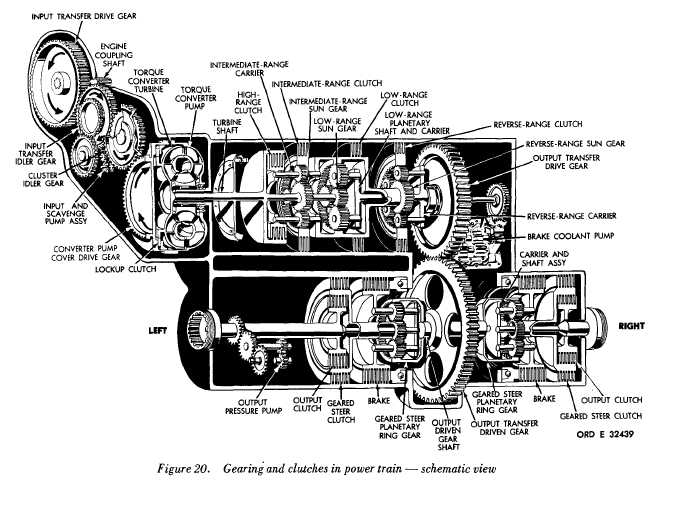Figure 20
P A R 4 3 - 4 4
T O R Q U E P A T H S
C H A P 2, SEC V
mitted hydraulically from the converter pump
t o t h e c o n v e r t e r t u r b i n e . W h e n t h e l o c k up
clutch is engaged, the pump and turbine are
locked together and torque is transmitted me-
c h a n i c a l l y .
b . W h e n t r a n s m i t t e d h y d r a u l i c a l l y , t he
torque maybe multiplied as much as 3.3 times
(at turbine stall). When transmitted mechani-
cally, torque leaving the converter is equal to
t h a t e n t e r i n g i t . T h e l o c k u p c l u t c h e n g a g es
and releases automatically.
c . At lower speeds, when high torque is
r e q u i r e d , t h e l o c k u p c l u t c h i s r e l e a s e d . At
higher speeds, when less torque is required,
the lockup clutch is engaged. Lockup engage-
m e n t c a n o c c u r i n e v e r y g e a r r a n g e a n d in
neutral. In figures 22 through 34 the converter
output is indicated by yellow when the lockup
clutch is released; by red when engaged.
4 4 . T O R Q U E P A T H - O U T P UT
TRANSFER GEARING (fig. 20)
a . Two gears makeup the output transfer
gearing. The drive gear is splined to the low-
range carrier shaft which is the range gearing
output for the power train regardless of which
gear is engaged.
The drive gear meshes with
the driven gear and imparts opposite rotation.
b . T h e d r i v e n g e a r t r a n s m i t s t o r q u e,
through a splined shaft, to the steer planetary
ring gears on either side of the driven gear.
The speed reduction, and corresponding torque
i n c r e a s e , i s 1 . 3 0 t o 1 . 0 0 .
4
7
|
|




